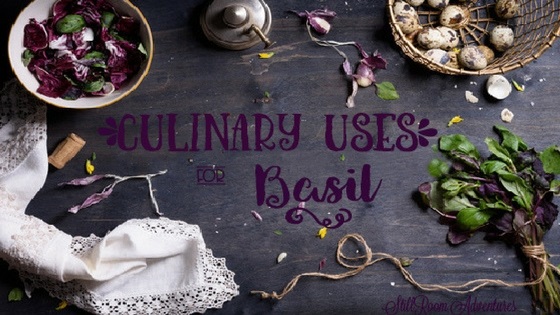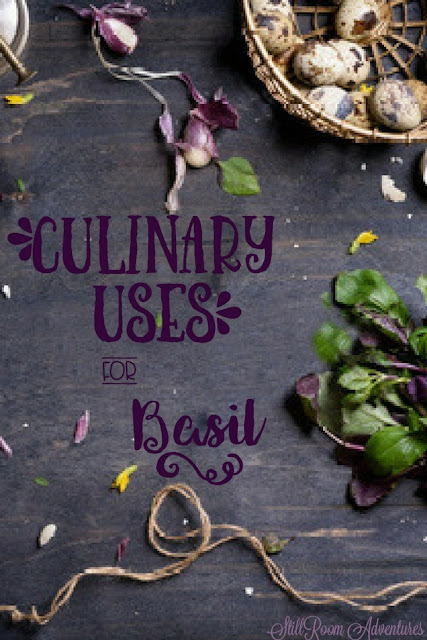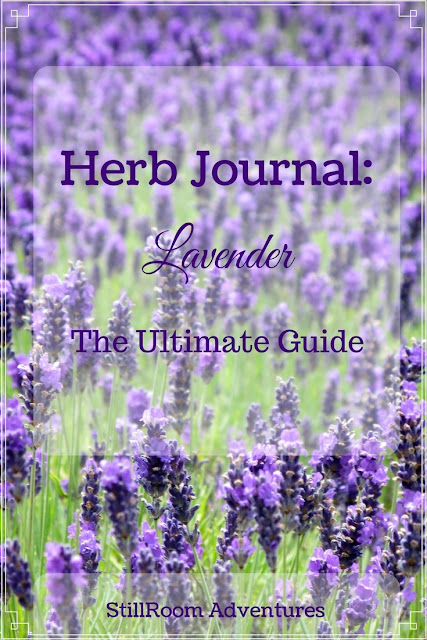Culinary Uses for Basil
The information that follows is excerpted from a longer post: The Ultimate Guide to Basil. For additional information about Basil such as its cultivation, medicinal uses, or how to harvest and store it, please click HERE to access the complete original post. Other individual sections are listed below:
The principal use for basil is culinary. Basil has a rich and spicy, mildly peppery flavor with a trace of mint and clove. Its flavor is quite unique and can vary significantly between cultivars. This is due to the huge number of volatile oils produced by the plant. More than 20 of them have been isolated and identified, but the concentrations in each plant vary. Each of the individual cultivars of the plant has different concentrations of these oils, as well, and concentrations differ among cultivars based on the region of nativity or origin of the plant. These oils are found, not only in basil, but in many other plants, as indicated by their names. Some of the oils include anise, cinnamon, clove, lemon, rose, lilac/orange blossom, thyme and camphor. The oils give the herbs bearing their names flavors unique to that plant, but combine in basil to create its own, almost indescribable, flavor.
When using basil in cooking, it is best to add the herb in only the last moments of cooking as it loses its flavor quickly when heated. To use the herb, pound it with oil or tear it into pieces with your fingers rather than chopping it. This keeps the oils and flavors trapped in the leaves. For best flavor, use fresh leaves. Fresh frozen leaves are the second best choice for cooking. Use the dried leaves only if fresh or frozen are unavailable.
Pesto and tomato sauce are the main dishes made from basil. Add basil leaves to a salad or use them to garnish just about anything. Because the flowers are edible, they make a lovely and delicious garnish, too. Basil is traditionally used in Italian, Mediterranean, and Thai cookery. It is also superb with veal, lamb, fish, poultry, white beans, pasta, rice, tomatoes, cheese, and eggs. It blends well with garlic, thyme, and lemon. Basil adds snap to mild vegetables like zucchini, summer squash, eggplant, potatoes, cabbage, carrots, cauliflower, parsnips, and spinach, as well as to the soups, sauces and stews in which these vegetables appear. Make basil vinegar using white vinegar. Dark opal basil makes an attractive purple vinegar that is very tasty.
Basil has a powerful enough flavor to stand up to garlic and together they make classic pesto sauce. You can create an easy pesto by combining 1 cup of fresh basil leaves, 3 Tablespoons of pine nuts or walnuts, 3 Tablespoons of grated Parmesan cheese and 2 or 3 cloves of garlic. Puree them all in a food processor or blender, adding just enough olive oil to make a smooth paste. Use with pasta, rice, fish, vegetables, or in soup. If you want to freeze your pesto sauce for later use, leave out the garlic as it may become bitter after a short while. Simply thaw the pesto and add the pureed garlic before serving.
An interesting fact about basil is that it is the primary ingredient in the liqueur Chartreuse. Basil gives this liqueur its almost neon, yellow-green color, but the liqueur gives the bright yellow-green color its name: chartreuse!
Here are a few chef tips for you to utilize basil in your own cooking.
- Add several large basil leaves to the liquid when poaching fish, shellfish, or chicken.
- Cut a 10 x 10 inch square piece of aluminum foil and set it shiny side down. Arrange slices of zucchini, onion, and tomato in the middle of the square and toss in several basil leaves. Fold the square around the vegetables to make a tight packet. Bake in a 350 degree oven, or grill, for about 20 minutes.
- Add a handful of basil when making beef stock.
- When making tomato or pizza sauce, substitute basil for the oregano.
- Whatever you do with basil, remember that its flavor intensifies with cooking and it can get very pungent very quickly, so only add it during the last few minutes of cooking.
Adding basil to foods, especially to uncooked foods, such as salads, acts as a natural preservative and can eliminate Shigella, an infectious bacterium that triggers diarrhea and may cause intestinal damage. Basil provides many essential nutrients and vitamins, too. Some of these include vitamin A, vitamin K, iron, calcium, manganese, copper, magnesium, vitamin C, and potassium. It also has anti-bacterial properties and contains DNA-protecting flavonoids.
Some recipes can be found below that use basil. Click on the links to give them a try!
I hope this gives you some ideas about how and when to use basil in your cooking. Please leave any questions or comments regarding cooking with basil below!















Comments
Post a Comment